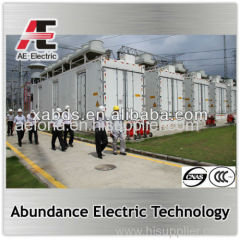|
Xian Abundance
|
static var compensator metallurgical equipment SVC
| Price: | 1.0~2.0 USD |
| Payment Terms: | T/T,L/C |
| Place of Origin: | Shaanxi, China (Mainland) |
|
|
|
| Add to My Favorites | |
| HiSupplier Escrow |
Product Detail
static var compensator(SVC)metallurgical equipment
SVC-solved problems
Electric arc furnace
When the electric arc furnace connects to grid as one nonlinear and ruleless load, it will trigger a series of harmful effects, which mainly includes:
1 severe 3-phase unbalance of grid, and negative sequence current.
2 higher harmonics, the coexistence of 2f, 4f, the even harmonics and 3f, 5f, 7f, the odd harmonics, which will be perplexed the voltage distortion.
3 severe voltage flicker.
4 Low PF.
The only way to completely solve above mentioned problems is that user must provide the SVC with rapid response speed for electric arc furnace. Since the response time of SVC is less than 10ms, it can completely meet the strict technical requirements, swiftly provide reactive current for EAF, stabilize system voltage, increase output of metallurgical active power and enhance production efficiency, as well as minimize the flicker effect. The phase splitting compensation capability of SVC can eliminate 3-phase unbalance caused by EAF. Harmonics filtering device can remove harmful higher harmonics, improve power quality and increase PF by transferring capacitive reactive power to system.
◆ Rolling mill
The reactive power impact caused by rolling mill and other industrial symmetrical loads during normal operation will cause the following effects for grid:
1 gird voltage decreasing and fluctuation, or even the electrical devices can not work normally, production efficiency will be reduced.
2 PF decreasing
3 Harmful higher harmonics existing in load transmission device, like 5f, 7f, 11f and 13f odd harmonics, will distort grid severely.
SVC can solve the above mentioned problems easily and perfectly, through stabilizing the busbar voltage without harmonics disturbance, making PF approaching to 1.
SVC principle
TCR type SVC is widely used in the world, it can eliminate reactive power impact, filter higher harmonics and balance 3-phase grid.
As shown in this diagram, SCV is connected with system, capacitor provides fixed capacitive reactive power Qc, current passing the compensated reactor determines the output value of inductive reactive power QTCR of compensated reactor, then inductive reactive power offsets capacitive reactive power. As long as system reactive power Qn=Qv (demand by system)-Qc+QTCR=constant (or 0), then grid power factor will equal to one constant, voltage will not be unstable any more. For this purpose, the contact angle of thyristor must be controlled precisely in order to get the required current value passing the compensated reactor, while converter and control system of thyrister can help to achieve this through calculating the contact angle opening after combining the collected current and voltage values of busbar reactive power, and comparing it with setting constant reactive power (maybe 0), and then setting the required current for thyrister by triggering device.





.jpg)





















